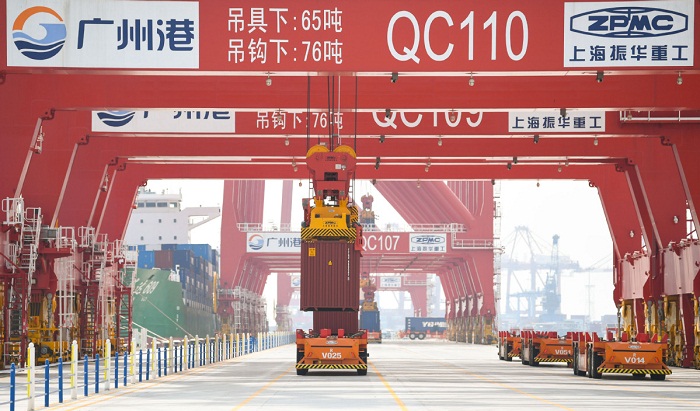Smart port epitomizes vitality of Greater Bay Area

A view of Nansha Port's fourth-phase project, an automated container terminal, in South China's Guangdong province, in July. [Photo/Xinhua]
GUANGZHOU — The clamor one would typically expect to see at a busy port is distinctly absent in the new automated container terminal of Nansha Port in South China's Guangdong province, the newest smart port in the Guangdong-Hong Kong-Macao Greater Bay Area.
Nansha Port, a major part of Guangzhou Port, built container terminals in four phases, handling over 18 million twenty-foot equivalent units in 2022. The automated container terminal, Nansha Port's fourth-phase project, has a designed handling capacity of 4.9 million TEUs a year.
No workers are seen on site as colossal bridge cranes precisely locate and lift containers from huge docked freighters, efficiently transporting them to automated vehicles.
The fully automated port has various functions, including smart vehicle dispatching, automated loading and unloading, driverless transport and intelligent tallying, said Song Xiaoming, deputy general manager of Guangzhou Port Group.
Intelligent management covers the whole production process at the terminal. Advanced information processing helps realize a seamless connection when cargo arrives, largely improving the efficiency of the port, Song added.
With its state-of-the-art design and technology, Nansha Port is an example of high-quality smart and automated transformation, epitomizing the GBA's development vitality.
The province's development and reform commission has urged efforts to boost the development of industrial clusters, promote traditional and new consumption, and build an international consumption hub in the GBA.
Guangdong's commerce department has revealed that the province saw exports increase 5.4 percent year-on-year in the first four months of 2023, with new energy vehicles, lithium batteries and solar cells seeing outstanding performances.
Data on Nansha Port's operations are also satisfying. In 2022, the volume of cold-chain cargo imported via the port exceeded 20 billion yuan ($2.8 billion), surging over 70 percent year-on-year.
Imported durian has flooded into China through the port. By the end of May this year, over 5,700 TEUs of durian had been imported via Nansha Port.
It takes four days for fresh Thai durian to arrive at Nansha Port, and only 1.5 hours to unload and transport the fruit to the largest fruit wholesale market in South China, said Chen Xi, deputy director of Nansha Customs.
This speed meets the requirements of the Regional Comprehensive Economic Partnership agreement, which is now in effect for all 15 members.
Under the agreement, specific goods are entitled to tariff reductions and exemptions. In 2022, over 60 million yuan in tariffs was deducted or exempted from cargo declared at Nansha Port worth a total of 4.2 billion yuan, Chen said.
The port has opened over 150 international freighter routes and its railway station has started handling China-Europe and China-Asia freight trains. With the full implementation of the RCEP, more routes will be explored to connect the GBA with the outside world to strengthen foreign trade, Song said.
All rights reserved. Presented by China Daily









